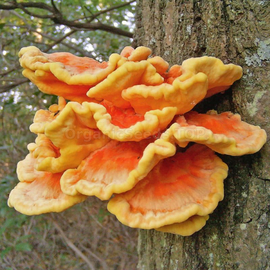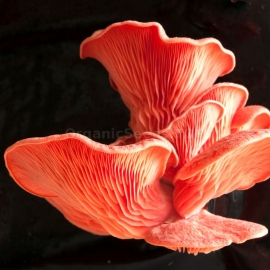 EXCLUSIVE
EXCLUSIVE
«Latipurus» (Laetiporus sulphureus) - Organic Mushroom Spawn
6.10 €
Latipurus belongs to the class of xylotrophs, affects the core of the tree, the fungus contains natural antibiotics that are active against staphylococci, and is used to treat malignant and benign tumors, lung diseases.
-
Organic Mushroom Spawn «Latipurus» (Laetiporus sulphureus)
Latipurus belongs to the class of xylotrophs, which attacks the core of the tree. Most of yoga can be commemorated on oak, willow, poplar, birch, linden, maple, pea, chestnut, fruit trees.
The fruit bodies of the latipurus are usually located on a tree trunk not high above the ground. In the first stage of development, the tinder fungus has the appearance of a drop-shaped yellowish fleshy mass located on a tree in the form of an influx. As it develops, the fruiting body hardens, acquiring the characteristic shape of an ear, which consists of several pseudocaps. The surface of the mushroom is always covered with light creamy-yellow fluff. The mass of the fungus can sometimes reach 10 kilograms. The fungus occurs from the last ten days of May to September, the most intensive growth is from the end of May to the end of June.
Useful properties
The fungus contains natural antibiotics that are active against staphylococci. Polypore sulfur yellowIt is used to treat malignant and benign tumors, lung diseases, diseases of the cardiovascular system, autoimmune diseases and allergic manifestations. Also, preparations from the fungus are used for alcoholism, epilepsy, and diabetes.
Taste and application
The name "mushroom chicken" gave the fungus a taste reminiscent of chicken breast. In Germany, North America, latipurus dishes are considered delicacy. It should be noted that only young mushrooms are used for food, which have a bright yellow color, with soft, tender flesh, moist to the touch. Old mushrooms that acquire a lighter color have a sour taste and are not suitable for food.
The pulp of the mushroom must be boiled for 30-45 minutes, then fried in breadcrumbs. The mushroom can be used to make salads, as a substitute for meat filling for pies . Latipurus is great for pickling, freezing. The dry flesh can be used to make an egg casserole.
yield
If favorable conditions are created for the latipurus mushroom, it will bear fruit in waves from May to July. The peak of fruiting falls on 2-3 years, the duration of fruiting, depending on the density of wood, is 3-7 years, when cultivated on stumps - up to 10 years. The total yield is 15-30% by weight of the substrate. You will be able to independently evaluate the taste properties and unusual appearance of this mushroom, since it is quite simple to grow it at home.
Other names: tree chicken, mushroom chicken, sulfur yellow tinderGrowing technology
SELECTION AND PREPARATION OF WOOD:
- Suitable stumps and logs of hardwood d≥15 cm, lying no longer than 4 months after cutting, with bark and without obvious signs of infection with other fungi.
- On the day of inoculation, the log is sawn into pieces of 30-50 cm.
- From the ends and around the perimeter, in a checkerboard pattern, at a distance of 10-15 cm, holes are drilled d 1 cm, h 5-6 cm - in a log at least 20, in a stump - 40 (Fig. 1). The more sticks, the sooner fruiting will begin.
- For 2-3 days, the logs are soaked in water, and the stumps are watered (Fig. 2). Excess water is allowed to drain. Freshly sawn (up to 1 month old) wood can be inoculated without soaking.
WOOD INOCULATING:
- Stumps are inoculated in spring, logs - in 2-6 months. before disembarkation. With clean hands, the sticks are inserted all the way and the holes are closed with plasticine or beeswax (Fig. 3).
- When inoculated in August-September, the logs are immediately planted in open ground, without waiting for overgrowth.
- It is recommended to tag the log with the name and date of inoculation.
INCUBATION (OVERGROWTH):
- The log is placed in a dark damp place (basement, barn) in a black bag with holes Ø 0.5-2 cm for ventilation and tied up. The stumps are covered with wet straw (burlap) and do not allow it to dry out, or they are tied with the same film (Fig. 4).
- Under favorable conditions - a temperature of 22-26 ° C and rel. ow. air 85-90% - the log will grow somewhere in 2-3 months. At lower rates, the overgrowth period increases.
LANDING FOR FRUITTING:
- Planted in open ground from April to September, in a container - all year round *. A place for fruiting is chosen shaded and well retaining moisture.
- An overgrown log is buried horizontally in a moistened hole, covered with a 2-5 cm layer of earth on top, or vertically by 1/3.
FRUIT AND YIELD:
- Depending on the density and size of the wood, it will bear fruit for 3-7 years in spring and autumn (Fig. 5).
- When planting mycelium in the ground in the spring, expect the first harvest this year, in the summer-autumn - next.
- A mushroom grown in the fresh air looks like a chanterelle. If, within 3-5 days from the moment the rudiments of mushrooms appear, a greenhouse effect (excess CO2) is created, then its leg will be thick, and the hat will be small.
- Productivity - 15-20% of the mass of wood. Weather conditions affect the yield and appearance of the fungus.
CARE:
- It is important to maintain the moisture of the mycelium by dripping the soil around, especially in dry, hot weather. After harvesting, watering is stopped for 7-14 days.
- In summer, the mycelium is protected from direct sunlight, and for the winter it is covered from frost with foliage and earth.
With this product buy
6.10 €
Traditional and contemporary Chinese medicine admire it as a tonic benefiting vital energy or "Qi", and it is popularly prescribed for a multitude of maladies. Reishi is a polypore mushroom, growing in damp, dark forests and the occasional rotting log.
6.10 €
Pink Oyster mushrooms are truly spectacular in their vibrant pink color. Our pink oyster strain is the pleurotus djamor var. roseus and is the most vibrant strain with pink gills. The vibrant pink varies by age and light conditions.
6.10 €
The saffron milkcap is one of the only edible milkcap mushrooms. It grows in the summer and autumn months under the canopy of pine trees and is distinguished by its convex cap with rolled lip, particularly noticeable in young specimens.
6.10 €
Fruit bodies of Agaricus bernardii have caps that range in shape from convex to flattened, and reach a diameter of 5–15 cm (2.0–5.9 in). The cap surface is dry and smooth, with a white or buff color that can develop brownish spots in maturity.




